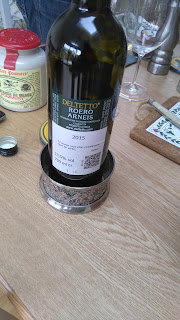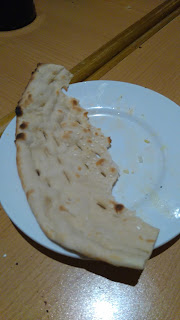 producers and appeared to be busy, though it was difficult to know how many of the visitors were buyers, and the wines on show were a good, representative mixture of what is happening on the Greek wine scene at the moment. The organisation was fine and the event ran smoothly, if you exclude the nibbles section; this was meant to be a bit of Greek cheese with bread and/or biscuits, but these ran out very early on, so staff were reduced to rushing around to the local supermarket for edam, crackers and basic baguette. The current impecunious condition of the Greek State explains some of this, the lack of planning ahead typical of modern Greece the rest. Still, overall I feel that the tasting was a success, which may or may not be reflected in the UK marketplace with a sale surge, thanks to the efforts of the small group of specialist importers promoting Greek wine. And against all the efforts of the Greek government, who are making wine exporters life more difficult instead of easier, by introducing petty short-sighted regulations rather than blessing and supporting any decent export activity.
producers and appeared to be busy, though it was difficult to know how many of the visitors were buyers, and the wines on show were a good, representative mixture of what is happening on the Greek wine scene at the moment. The organisation was fine and the event ran smoothly, if you exclude the nibbles section; this was meant to be a bit of Greek cheese with bread and/or biscuits, but these ran out very early on, so staff were reduced to rushing around to the local supermarket for edam, crackers and basic baguette. The current impecunious condition of the Greek State explains some of this, the lack of planning ahead typical of modern Greece the rest. Still, overall I feel that the tasting was a success, which may or may not be reflected in the UK marketplace with a sale surge, thanks to the efforts of the small group of specialist importers promoting Greek wine. And against all the efforts of the Greek government, who are making wine exporters life more difficult instead of easier, by introducing petty short-sighted regulations rather than blessing and supporting any decent export activity.I cannot understand the thinking behind Greek politicians and bureaucrats, small-minded, short-termist and petty, and against the very people (exporters) who can help the cash-strapped country earn some valuable foreign currency. But no, why bother with creative economic activity when we can reduce pensions further and tax property owners until the pips squeak, despite the fact that these tactics have not worked and are
 destructive, driving what's left of the productive economy into the ground. This is sad and unnecessary, stupid even, but producers at the tasting put on a brave face and did their best for their products, and their country.
destructive, driving what's left of the productive economy into the ground. This is sad and unnecessary, stupid even, but producers at the tasting put on a brave face and did their best for their products, and their country.Greek wine has never had a huge market in the UK, despite their being quite a few greek restaurants all over the place. In the past this was certainly, at least partly, down to the mediocre quality of the mainstream wines available, but in the last 30 years there has been a huge change in the picture, with the old, once dominant, large companies playing second fiddle to adventurous independent estates with young winemakers bursting with new ideas. The leap in quality, mirrored in other traditional wine-making countries (Portugal, for example...), has been impressive, with Greek varieties being rediscovered or reworked in more modern or better ways, and international varieties also growing and glowing. The wines are good enough in quality terms to compete now, their standards of presentation also; some are even stars by international standards. Why are they not taking the market by storm?
1. Past impressions/past reputation.
2. Retsina (real or imagined experience of poor examples thereof).
3. Little proper support from the Greek state, ever - compare to Spain (for example) and others.
4. Relatively high prices.
5. Most tourists tend to drink 'house' wines, which are poor or indifferent, but cheap.
6. Lack of focus/understanding of the international market by producers.
Still, with things much better in quality terms, I chose a selection of wines to taste, some familiar, others new to me. Overall I was impressed by the standards on show, but let me be a bit more specific about the main points.
The now established stars in international terms are the white wines of Santorini, the small volcanic island at the southern end of the Cyclades, with the stunning scenery and sunset. Produced in the most inhospitable landscape and threatened by property development, they are now acknowledged to be individual and generally of exceptional quality, with a unique taste. Having tasted most of the wines on show I found them all to be impressive, but my personal choice on the day would be the Argyros range, which to me showed more freshness, and were perfectly balanced. Not one of the wines I tasted was disappointing or poor, but they are now with prices to match - no more bargains from Santorini, I'm afraid! Most everyone said that the 2016 vintage is near perfect for the Santorini white wines, so it will soon be time to try and buy...
The other star from Santorini is, of course, its sweet wine (Vinsanto); at its best it is a match for any sweet wine from anywhere in the world. Whilst I liked the examples on show I was not entirely bowled over, or not as impressed as I had expected to be - was I expecting too much?
One of the wines that in my opinion is deservedly on its way to the top is the humble Savatiano, which is traditionally grown in Attica, near Athens, long pooh-poohed and used in the past mainly to make Retsina. The variety, properly utilised, produces a subtle wine that can be complex and beguiling, with a slightly aromatic nose. In the past it was thought to lack character but that is wrong, though badly made examples are boring, and was mixed with more flowery varieties to mutual detriment. These days are nearly at an end, so be prepared for some impressive single variety Savatiano wines to be the new stars from Greece. Unfortunately there is a downside, as this most reasonably priced of wines is becoming more expensive by the minute.
In theory Greece, with its mainly hot climate, should be great for big red wines, and there is a bit of a tendency to make these. What a lot of people ignore, though, is that bits of northern Greece get very cold winters and fairly mild summers, producing more complex, delicate reds like in the Naoussa region with its Xynomavro (sour black) grape variety, somewhat reminiscent of Burgundy Pinot Noir styles. Winemakers in other areas with individual microclimates are also making more complex, less aggressively big red wines, to the benefit of those of us who favour subtlety over obviousness.
So in conclusion, Greek wine put on a good show in these difficult times as far as this tasting is concerned. As far as the marketplace goes, there is a lot more work to be done, at least in the U.K., though things are moving in the right direction. If only this effort by the long-suffering importers, the producers, even the potential buyers was somewhat supported by Greece itself.
I have lots of individual opinions and detailed notes which will follow in the next week or so as a separate piece to make life easier for my myriads of readers.












